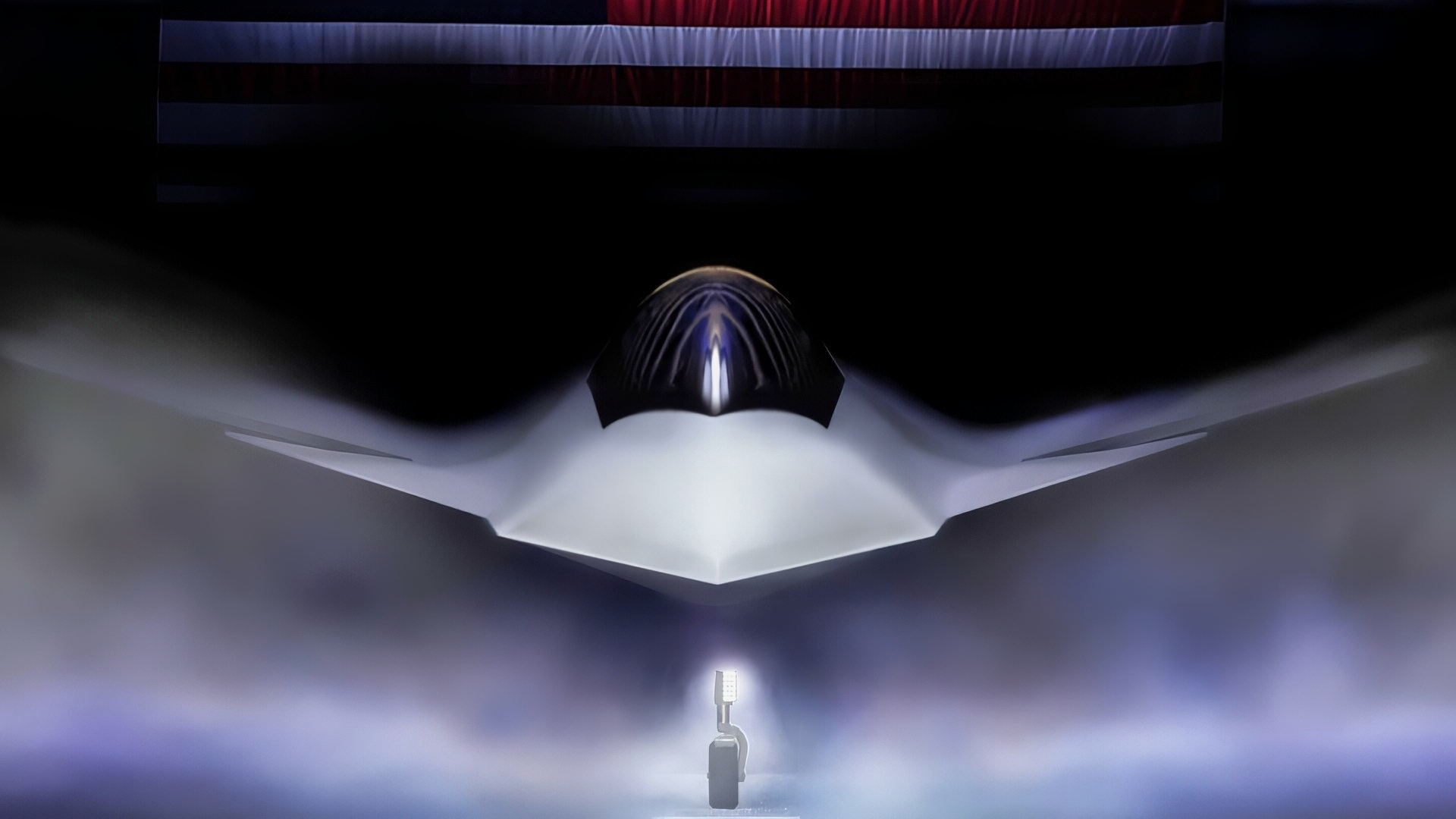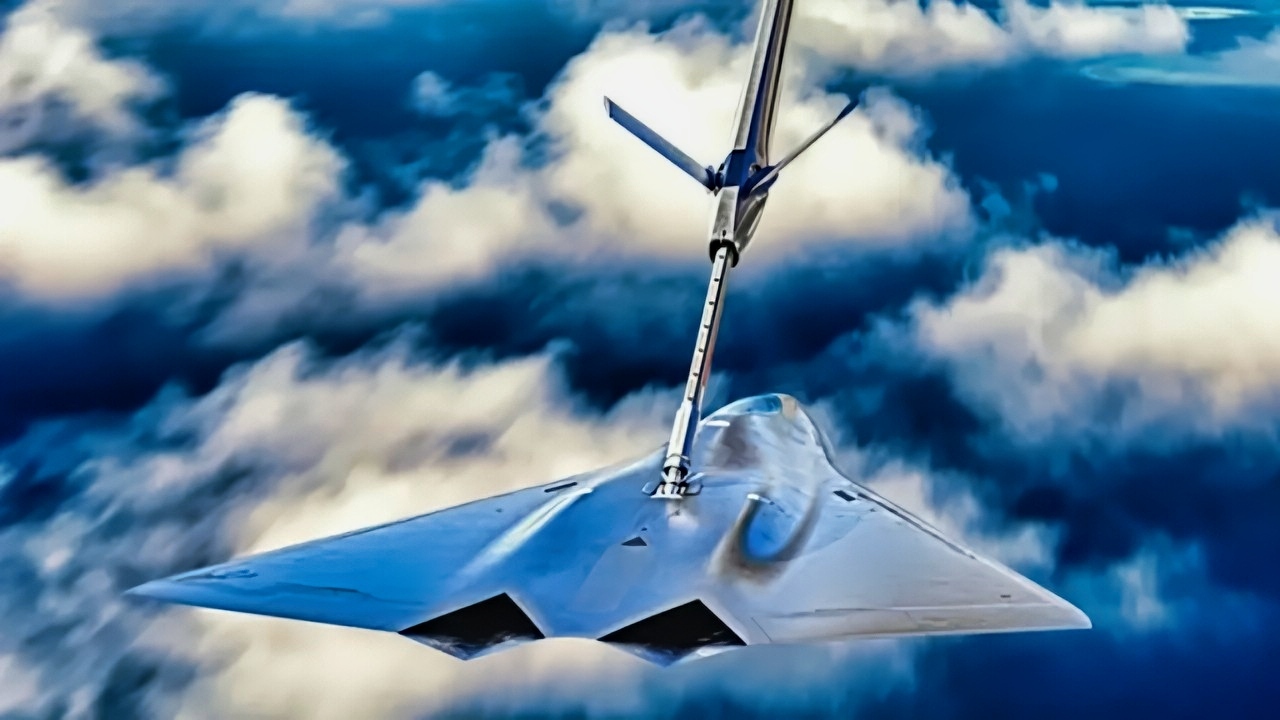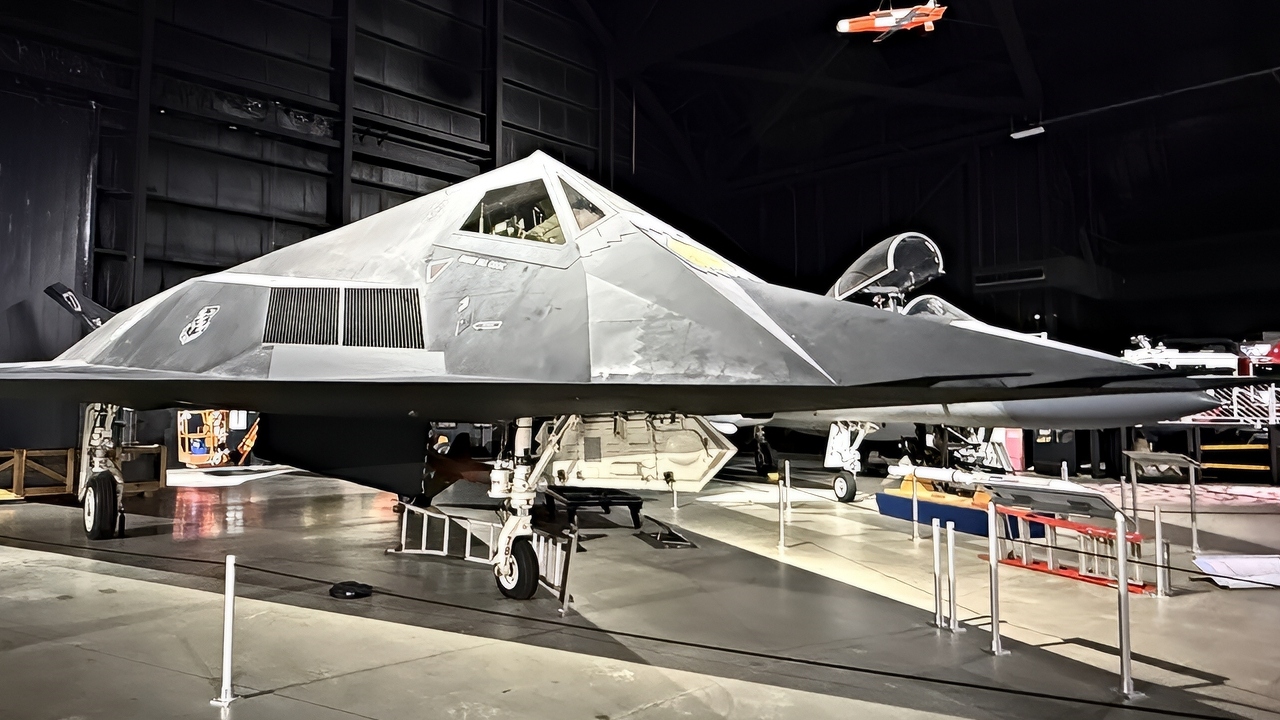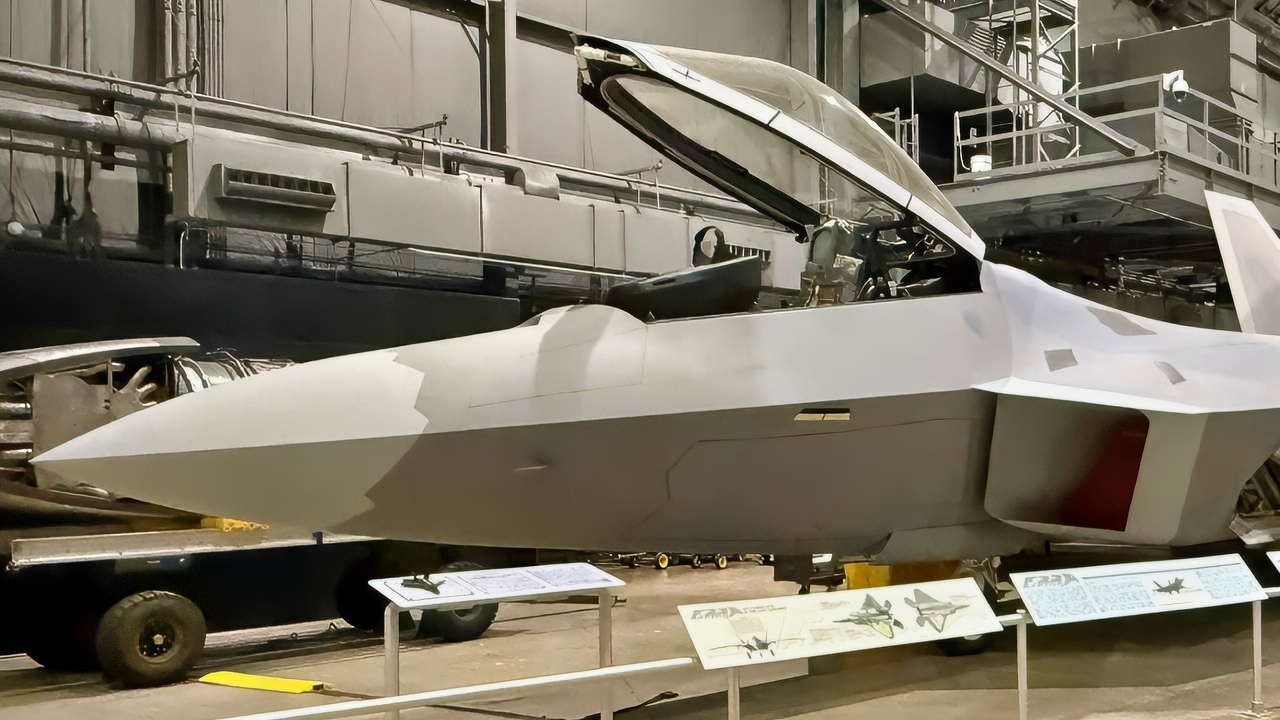Key Points and Summary – The F-47 NGAD is pitched as a true leap: a long-range, Mach-2-plus stealth “quarterback” that commands swarms of Collaborative Combat Aircraft for sensing, jamming, decoy and strike.
-A next-gen “Stealth++” design promises far lower observability than fifth-gen jets, while emerging ceramic radar-absorbent coatings aim to survive heat, rain and abrasion at high speed.

Shown is a graphical artist rendering of the Next Generation Air Dominance (NGAD) Platform. The rendering highlights the Air Force’s sixth generation fighter, the F-47. The NGAD Platform will bring lethal, next-generation technologies to ensure air superiority for the Joint Force in any conflict. (U.S. Air Force graphic)

F-47 Lockheed Photo. Image Credit: Lockheed Handout.
-With a combat radius over 1,000 nautical miles, the F-47 pushes tankers back and reach forward—vital for the Pacific. Big bets by industry and a ramping budget signal urgency.
-If manned-unmanned teaming, open systems and durable stealth mature on schedule, the F-47 could redefine air dominance.
What Will Make The F-47 NGAD Transformative?
The Air Force’s new NGAD F-47, a sixth-generation stealth fighter, promises to revolutionize the way we view fighter aircraft.
The head of Boeing Defense, Space & Security is so confident in the company’s ability to execute the F-47 program that he believes it will change everything.
“From my perspective, the F-47 is transformational for Boeing, as the first sixth-generation fighter that will ever be produced,” said Steve Parker, interim president and chief executive at the unit.
“What defines it for me is the investment we’ve made over a long period of time, over a decade-plus, in advanced materials, material sciences, advanced manufacturing, survivability, and lethality.”
So confident was Boeing about the F-47 that in 2024, it also made the risky decision to invest approximately $2 billion in a classified combat aircraft production facility before the outcome of the NGAD competition was announced.
The Pentagon Is Investing Heavily In 2026
The Pentagon’s proposed FY 2026 Budget shows that the Department of Defense (DoD) is fully committed to the new F-47 stealth fighter. And new details of the stealth fighter are now slightly clearer thanks to USAF Chief of Staff, General David Allvin.

F-47. X Screenshot.
Secretary of Defense Pete Hegseth revealed the $3.5 billion amount at a Congressional hearing in June.
What Will Make The F-47 Transformative?
However, this raises the question: what exactly will make the F-47 so impressive? How will it be so transformative? Not much is known yet, and we’re certainly waiting to see exactly WHAT it looks like. But this much is known.
The F-47 will be transformative through its use of manned-unmanned teaming with drone wingmen, its advanced sixth-generation capabilities like superior stealth and AI, and its role as a networked “quarterback” for a broader combat system. It’s designed to replace the F-22 with a long-range, high-speed aircraft that can act as a command and control hub, enabling it to perform complex, deep-strike, and ISR missions more effectively.
The Air Force’s Next Generation Air Dominance (NGAD) sixth-generation fighter, the F-47, will feature a combat radius exceeding 1,000 nautical miles, a speed surpassing Mach 2, advanced stealth capabilities, and a cost potentially around $300 million per aircraft.
Some details that we do know are added here:
QB of a Collaborative Combat Aircraft (CCA) Formation
According to the graphic that Gen. Allvin showed in the White House, the Air Force plans to acquire at least 185 F-47s; this could provide it with enough aircraft to replace the Raptor fleet on a one-to-one basis, but that figure can be a bit misleading.
The F-47 will control a swarm of AI-driven drones, CCAs, from its cockpit. This “quarterback” role allows the manned F-47 to operate at a safe distance.
At the same time, the CCAs perform tasks such as penetrating high-threat areas, conducting reconnaissance, jamming enemy systems, or acting as decoys. The drones have autonomous maneuvering capabilities, and the F-47 receives data and provides command and control through a secure, jam-resistant link.
The F-47, the quarterback of several drone wingmen, with initial assessments suggesting that each new fighter would be paired with at least two, and possibly as many as five, AI-enabled drone wingmen.
However, more recent tests by Lockheed Martin have shown that the final figure could be significantly higher, demonstrating the ability to control up to eight drones from a single F-35.
That means each of the 185 new F-47s should be thought of as a fighter formation unto itself, rather than as a single jet.
Excellent Speed
The F-47 is expected to exceed Mach 2 (1,500 mph, 2,400 km/h), indicating high supersonic speeds. The exact speed is classified, but reports suggest it could be Mach 2.25 (approximately 1,726.35 mph) or higher.
President Trump said, “Its speed is top, so ‘over two,’ which is something that you don’t hear very often.”
“It’s something the likes of which nobody has seen before,” Trump said. “In terms of all of the attributes of a fighter jet, there’s never been anything even close to it, from speed to maneuverability, to what it can have as a payload. The F-47 will be the most advanced, most capable, most lethal aircraft ever built.”
That speed is incredible for a stealth aircraft, but how can the F-47 maintain its stealth coatings at such a speed?
New Stealth Coatings Are The Key
Stealth coating materials can deteriorate due to both speed and temperature. High speeds, especially supersonic flight, generate significant heat, which can damage or degrade the radar-absorbing materials (RAMs) used in stealth technology. Additionally, the materials are susceptible to damage from abrasion, moisture, and other environmental factors.
Many radar-absorbent polymers used in stealth coatings rapidly decompose at temperatures above 250°C. This necessitates careful design considerations to manage heat and protect the coatings.
Scientists at NC State have been working on creating a tougher skin that also has more desirable stealth characteristics. Researchers believe that the new material will enable the aircraft to fly at higher speeds while maintaining its stealth capabilities.
Chengying “Cheryl” Xu, who is leading the program at NC State, said that “the material we’ve engineered is not only more radar absorbent, it will also allow the next generation of stealth aircraft to be faster, more maneuverable and able to travel further.”
Xu and her team have developed a ceramic material with an impressive array of stealth attributes. During lab testing, it was found that the ceramic is more radar-absorbent than existing polymers, capable of absorbing 90% or more of incident radar energy.
The ceramic material is water-resistant and harder than sand. In other words, it can better withstand harsh conditions, such as flying in desert-like environments or in the rain. More importantly, the ceramic material retains its radar-absorbent characteristics over a wide temperature range, from as high as 1,800 °C to as low as -100 °C.
The ceramic coating can be applied easily to the entire skin of the aircraft. The whole process, from using a liquid ceramic precursor to completion, takes one to two days, Xu said.
The liquid ceramic precursor is sprayed onto the aircraft’s surface. As the liquid precursor is exposed to ambient air, it undergoes a series of chemical reactions, converting it into the solid ceramic material.
Stealth Capabilities
While the F-35 was described as a “stealth” aircraft, as were the CCAs, the F-22 was described as a “Stealth +” type. In contrast, the F-47 was described as “Stealth ++,” consistent with service comments that it would have to be substantially stealthier than the F-22 to survive anticipated adversary air defenses.
Alex Hollings of Airpower and Sandboxx provides a detailed explanation of the complex calculations involved in radar cross sections and stealth.
“Radar cross sections are notoriously difficult to calculate and vary depending on radar frequency and angle of observation, but speaking in general terms, the F-35’s radar cross section is estimated to be .005 square meters – nearly half the size of the F-117 Nighthawk on radar scopes.

F-117 Stealth Fighter Static Display. Image Credit: National Security Journal.
“But the larger and stealthier F-22 Raptor is said to have a frontal radar cross section of an incredible .0001 square meters – an astonishing 50 times smaller than the very stealthy F-35.
“If that difference is encapsulated in the distinction between ‘Stealth’ and ‘Stealth+’ on this graphic, then it suggests the F-47 that is designated as ‘Stealth++’ may be the stealthiest fighter ever designed by a wide margin.”
Significantly Better Range Than The Raptor
The F-47 will have a combat radius of over 1,000 nautical miles (1,150 miles, 1,850 kilometers), significantly further than the F-22’s range, according to an infographic posted Tuesday on X by Air Force Chief of Staff Gen. David Allvin.
Defense One reports that this extended range will allow tankers to stay further from the action, a key advantage in potential conflicts, especially in the Pacific theater.
The Cost Will Be Steep
Initial estimates place the cost of an individual F-47 at around $300 million. While this is significantly more than the F-35, it’s projected to be less expensive than the F-22.

F-22A Raptor Side Angle National Security Journal Photo.
The Air Force has requested $2.7 billion for the platform in its fiscal 2025 budget, indicating its commitment to the program, according to DefenseScoop.
The total cost of the F-47 program is expected to be high, with some estimates reaching $55.5 billion, including the initial development costs.
“Air dominance is not a birthright, but it has become synonymous with American air power,” General Allvin said. This program is “our commitment to the fight.”
“Compared to the F-22, the F-47 will cost less and be more adaptable to future threats—and we will have more of the F-47s in our inventory,” Allvin said in a statement.
“The F-47 will have significantly longer range, more advanced stealth, be more sustainable, supportable, and have higher availability than our fifth-generation fighters. This platform is designed with a ‘built to adapt’ mindset and will take significantly less manpower and infrastructure to deploy.”
About the Author: Steve Balestrieri
Steve Balestrieri is a National Security Columnist. He served as a US Army Special Forces NCO and Warrant Officer. In addition to writing on defense, he covers the NFL for PatsFans.com and is a member of the Pro Football Writers of America (PFWA). His work was regularly featured in many military publications.
More Military
Russia’s Mach 2 Su-30SM Fighter Has A Message for Any Air Force on Earth
The Mach 2.2 B-1A Bomber Has A Message for the U.S. Air Force
The Mach 2.35 ‘Super’ Eurofighter Typhoon Fighter Has a Message for Any Air Force On Earth
Canada’s CF-18 Hornet Fighter Crisis
Forget NGAD or the J-20: A 7th Generation Fighter Could Hit Mach 5










